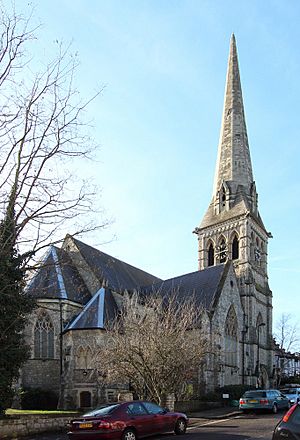Holy Trinity Church, Tulse Hill facts for kids
Quick facts for kids Holy Trinity Church, Tulse Hill |
|
|---|---|
 |
|
| 51°26′42.2″N 0°6′33.8″W / 51.445056°N 0.109389°W | |
| Denomination | Church of England |
| Architecture | |
| Architect(s) | Thomas Denville Barry |
| Administration | |
| Deanery | Lambeth South Deanery |
| Archdeaconry | Lambeth |
| Diocese | Diocese of Southwark |
| Province | Canterbury |
Holy Trinity Church is a beautiful old church located on Trinity Rise in the Tulse Hill area of London. It is a very important building, officially recognized as a Grade II Listed Building. This means it has special historical or architectural value and is protected.
The Church's Community Area
In the early 1800s, the area around Holy Trinity Church grew quite a lot. Many large, fancy houses were built here.
The church's local area, known as a parish, was officially created in 1856. It was formed from parts of three other church parishes: St Luke West Norwood, St Matthew Brixton, and St Leonard's, Streatham.
Over the years, the number of people living in the parish changed. For example, in 1886, about 6,300 people lived there. The church had three clergy (church leaders) serving the community. About 23% of the people attended church services.
By 1901, the population in the parish was around 4,100. The church then had two clergy members, and about 22% of the local people attended services.
More recently, the population has grown again. Based on information from the UK census, the Diocese of Southwark estimates that the Holy Trinity & St Matthias parish had about 11,000 people in 2001. By 2011, this number had increased to about 13,700 people.
A very important person, John Sentamu, used to be the vicar (the main priest) at Holy Trinity Church for 13 years. He later became the Archbishop of York, which is a very high position in the Church of England.
The Church Building
Holy Trinity Church is built using strong brickwork, covered with a type of stone called Kentish ragstone. Its roof is made of slate. The church's design is in a style popular in the 14th century.
Inside, the church has a main area called the nave, with side sections called aisles. It also has transepts (parts that stick out like arms of a cross) and a chancel with an apse (a rounded end). The way it's built means that there are no pillars blocking the view of the pulpit (where sermons are given) or the altar (the table used for communion).
You enter the church from the north side, under a tall tower. This tower supports a broach spire, which is a pointy top made of dressed bath stone. The church has three special windows in the apse (on the north, east, and south sides). These beautiful stained glass windows were created by an artist named Clare Dawson. She was a student and worked with another famous stained glass artist, M. E. Aldrich Rope.

